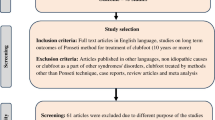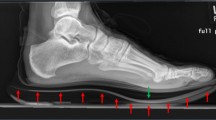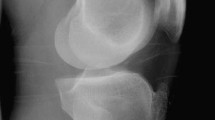Abstract
Os vesalianum pedis is a rare accessory ossicle located at the 5th metatarsal base. This anatomic variation is typically asymptomatic and usually detected incidentally on routine foot radiographs. However, it may be a source of lateral foot pain and rarely become symptomatic following traumatic ankle injuries such as an inversion ankle sprain. To date, seven symptomatic os vesalianum pedis cases that required surgical treatment have been reported in the current literature. Herein, a 17-year-old professional football player with a symptomatic os vesalianum pedis was presented. The ossicle was surgically removed upon failure of conservative treatment. At the sixth month, the patient returned to sport without any restriction or pain. Clinical presentation, diagnosis, and treatment options of symptomatic os vesalianum pedis were discussed with an extensive literature review.








Similar content being viewed by others
References
Keles-Celik N, Kose O, Sekerci R, Aytac G, Turan A, Güler F. Accessory ossicles of the foot and ankle: disorders and a review of the literature. Cureus. 2017;9(11):e1881. https://doi.org/10.7759/cureus.1881.
Vesalius A. De Pedis Ossibvs. De Humani Corporis Fabrica, p 142, 1543.
O’Rahilly R. A survey of carpal and tarsal anomalies. J Bone Joint Surg Am. 1953;35-A(3):626–42.
Tsuruta T, Shiokawa Y, Kato A, Matsumoto T, Yamazoe Y, Oike T, et al. Radiological study of the accessory skeletal elements in the foot and ankle. Nihon Seikeigeka Gakkai Zasshi. 1981;55(4):357–70 Japanese.
Coskun N, Yuksel M, Cevener M, Arican RY, Ozdemir H, Bircan O, et al. Incidence of accessory ossicles and sesamoid bones in the feet: a radiographic study of the Turkish subjects. Surg Radiol Anat. 2009;31(1):19–24. https://doi.org/10.1007/s00276-008-0383-9.
Cilli F, Akçaoğlu M. The incidence of accessory bones of the foot and their clinical significance. Acta Orthop Traumatol Turc. 2005;39(3):243–6.
Baastrup CI. Os vesalianum tarsi and fracture of the tuberositas ossis metatarsi V. Acta Radiol 1:334–348, 1921–1922.
Smith AD, Carter JR, Marcus RE. The os vesalianum: an unusual cause of lateral foot pain a case report and review of the literature. Orthopedics. 1984;7(1):86–9. https://doi.org/10.3928/0147-7447-19840101-12.
Inoue T, Yoshimura I, Ogata K, Emoto G. Os vesalianum as a cause of lateral foot pain: a familial case and its treatment. J Pediatr Orthop B. 1999;8(1):56–8.
Wilson TC, Wilson RC, Ouzounov KG. The symptomatic os vesalianum as an uncommon cause of lateral foot pain: a case report. J Am Podiatr Med Assoc. 2011;101(4):356–9.
Dorrestijn O, Brouwer RW. Bilateral symptomatic os vesalianum pedis: a case report. J Foot Ankle Surg. 2011;50(4):473–5. https://doi.org/10.1053/j.jfas.2011.03.012.
Petrera M, Dwyer T, Ogilvie-Harris DJ. A rare cause of foot pain with golf swing: symptomatic os vesalianum pedis-a case report. Sports Health. 2013;5(4):357–9. https://doi.org/10.1177/1941738113482446.
Beil FT, Burghardt RD, Strahl A, Ruether W, Niemeier A. Symptomatic Os Vesalianum. A case report and review of the literature. J Am Podiatr Med Assoc. 2017;107(2):162–5. https://doi.org/10.7547/15-160.
Sarrafian SK, Kelikian AS. Development of the Foot and Ankle. Sarrafian’s Anatomy of the Foot and Ankle. Editor: Kelikian AS. Third Edition. Lippincott, Philadelphia, 2011. Page. 3–39.
Dameron TB Jr. Fractures and anatomical variations of the proximal portion of the fifth metatarsal. J Bone Joint Surg Am. 1975 Sep;57(6):788–92.
De Cuveland E. The apophyses of the fifth metatarsal and of the os vesalianum. Fortschr Geb Rontgenstr. 1955;82(2):251–7.
Northover JR, Milner SA. A case report of an accessory bone in the foot. Foot (Edinb). 2006;16(3):172–4. https://doi.org/10.1016/j.foot.2006.02.004.
Kose O. Os vesalianum pedis misdiagnosed as fifth metatarsal avulsion fracture. Emerg Med Australas. 2009;21(5):426. https://doi.org/10.1111/j.1742-6723.2009.01221.x.
Tiwaria M, Khannaa V, Kodidea U, Vaishyab R. Os vesalianum—a confounding diagnosis. Apollo Med. 2015;12(4):285–6. https://doi.org/10.1016/j.apme.2015.09.002.
Boya H, Ozcan O, Tandoğan R, Günal I, Araç S. Os vesalianum pedis. J Am Podiatr Med Assoc. 2005;95(6):583–5.
Boya H, Oztekin HH, Ozcan O. Abnormal proximal fifth metatarsal and os vesalianum pedis. J Am Podiatr Med Assoc. 2007;97(5):428–9.
Kose O. The accessory ossicles of the foot and ankle; a diagnostic pitfall in emergency department in context of foot and ankle trauma. JAEM. 2012;11:106–14.
Muehleman C, Williams J, Bareither ML. A radiologic and histologic study of the os peroneum: prevalence, morphology, and relationship to degenerative joint disease of the foot and ankle in a cadaveric sample. Clin Anat. 2009;22(6):747–54. https://doi.org/10.1002/ca.20830.
Deniz G, Kose O, Guneri B, Duygun F. Traction apophysitis of the fifth metatarsal base in a child: Iselin’s disease. BMJ Case Rep. 2014. https://doi.org/10.1136/bcr-2014-204687.
Ralph BG, Barrett J, Kenyhercz C, DiDomenico LA. Iselin’s disease: a case presentation of nonunion and review of the differential diagnosis. J Foot Ankle Surg. 1999;38(6):409–16.
Kim MH, Kim WH, Kim CG. Kim DW. Os vesalianum pedis detected with bone SPECT/CT. Clin Nucl Med. 2014;39(2):e190–2. https://doi.org/10.1097/RLU.0000000000000305.
Author information
Authors and Affiliations
Corresponding author
Ethics declarations
Conflict of interest statement
The authors declare that they have no conflict of interest.
Informed consent
Written informed consent has been obtained from the patient for publication of medical records and imaging.
Additional information
Publisher’s note
Springer Nature remains neutral with regard to jurisdictional claims in published maps and institutional affiliations.
Rights and permissions
About this article
Cite this article
Aykanat, F., Vincenten, C., Cankus, M.C. et al. Lateral foot pain due to os vesalianum pedis in a young football player; a case report and review of the current literature. Skeletal Radiol 48, 1821–1828 (2019). https://doi.org/10.1007/s00256-019-03190-4
Received:
Revised:
Accepted:
Published:
Issue Date:
DOI: https://doi.org/10.1007/s00256-019-03190-4




